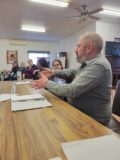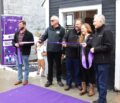Headline News
Preventing crime through environmental design
October 14, 2020
Oct. 14, 2020
By Kristena Schutt-Moore
Over the past couple months there has been an increase in calls to the Bancroft OPP Detachment about trespassing, suspicious persons, destruction of property and even theft under $5,000. These calls have been coming in from throughout the detachment area. It has made the Bancroft Detachment one of the few detachments in Ontario that have seen an increase in calls since the start of COVID-19.
There could be a number of reasons for the increase of issues in the area, but one of the best ways that community members can help prevent such crimes is through Crime Prevention Through Environmental Design. With CPTED a home or business owner can plan out the environment around their space, including buildings and landscape, to make it more difficult for would-be criminals.
The Bancroft Times talked with senior constable Michael Szusz, a member of the Bancroft OPP Detachment who is trained in CPTED, about how CPTED works.
“It need not be expensive or be difficult to apply. A proper design of property and using the natural environment effectively can reduce crime and improve the quality of life by reducing fear.” explains Szusz.
Szusz says that CPTED is most effective when multiple strategies of CPTED are being used at the same time. There are several strategies to work with, but for those just learning about the concept Szusz suggests focusing on natural surveillance, territorial reinforcement, target hardening and natural access control.
With natural surveillance the trick is to keep the would-be criminals easily observable by the public. “We know that criminals don’t want to get caught,” says Szusz. “So They are less apt to commit crimes if there is natural surveillance and the public can easily see them.”
There are ways to improve the natural surveillance of a property. A property owner can trim their trees up at least seven feet high and have all shrubs trimmed lower than three feet, and don’t have any heavy or dense shrubbery growing near windows and doors. This will leave an open line of sight, leaving would-be criminals exposed to being seen and being caught.
The same concept can be used inside a building by having all points in a store easily seen through decluttering, open lines of site from a main area, such as the cashier. Having windows blinds open and posters removed from windows will also improve lines of sight both in and out of the building.
An example of this being put into place is in Millennium Park. In the park itself the trees are all trimmed up which allows for an unobscured view and natural surveillance in and around the park. Currently the concern is along the York River and Heritage Trail. The overgrown bushes, tree line has allowed for a blocked view of public property. This property is now being used as a squatting or camping area.
Territorial reinforcement is a physical design that can extend a sphere of influence. This can include features that define a property, property lines and distinguish private places from public spaces. This can be done through landscaping.
“In my opinion territorial reinforcement is often overlooked entirely,” says Szusz.
One example of territorial reinforcement is to have uneven or uncomfortable ground in areas where people standing around will be unwanted, a shrub garden outlining boundary lines or decorative low resting rock wall that defines the lines between public and private areas. Two examples of this is the shrub garden at Parkview Dental and the rock wall at Dixie Lee along the main street.
Modern homes are often not built with territorial reinforcement in mind. The small front porches and garages that extend out past the front door does not invite regular or comfortable use or a safe line of sight from the front door. Back in the sixties when houses and private properties often had the small white picket fences and the large front porches, families often made more use of the space and the open space and clearly marked boundaries with clear lines of site, gave would-be criminals a more difficult time gaining ease of access.
It’s about the barriers, explains Szusz, “Physiologically, you see the fence and you’re going to think, I’m not supposed to be behind there. The next barrier is the porch and the next is the door. So that is where you get into the defining spaces.”
Territorial reinforcement clearly defines where people are allowed to be, and when.
Natural access control is similar in that it works to control access to crime targets and create an offender’s perception of risk. This can be created using fences. One of the areas in town that is a concern and natural access control could be put into use is all the alleyways in Bancroft that are in between the buildings along the town’s main street.
“Those are not public areas, they are not for public use. But they do get used for nefarious acts.” Says Szusz.
A way to remove the risk of inappropriate use of these areas could be fences or garden areas such as the one next to the McCaskie building. Strategies such as these, give the perception of boundaries and lets the public and would-be criminals know that the area is not somewhere they are permitted to be in.
Target hardening includes the use of items such as security systems, camera systems, security posters and security window films. This makes the intended target of a crime more difficult for would-be criminals to access. It is about making the property less attractive to would-be criminals.
Landscaping can also be put into place such as using thorny shrubs, uneven ground and bright lighting that shines up from ground level up. These don’t have to detract from the beauty of a home or business, but it can make it more difficult to loiter and gain access to areas that a person is not allowed to be in, and not allowing for places for an intruder to hide.
“CPTED is important because it has an element of community policing to it,” explains Szusz. “The police are not going to deter crime alone. This is a partnership. CPTED empowers people to take an active role in their own safety and security.”
The Bancroft OPP are willing to talk and meet with businesses and property owners within their district about CPTED. Those interested in learning more are invited to contact the Bancroft OPP Detachment at 613-332-2112. Szusz is willing to tour a business and help a property owner have a better understanding of CPTED and some possible improvement that they could make to their properties. This is to help both businesses, property owners and the community as a whole build Crime Prevention Through Environmental Design.


















